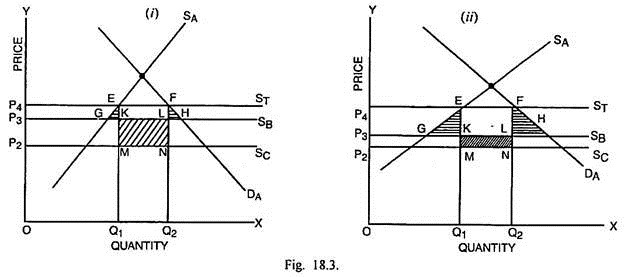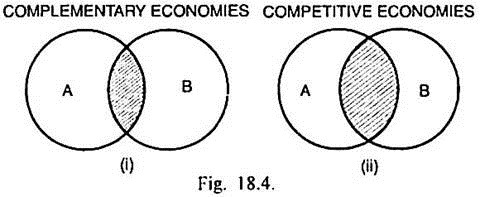Whether a customs union will increase or reduce net welfare is conditioned by the following factors:
Effect # 1. Varying Elasticities of Demand and Supply Curves and Equal Price Differences:
If the differences between pre-union free trade price (P2), the pre- union tariff-ridden price (P4) and post-union member country’s price (P3) are exactly equal (P2P3 = P3P4) but the elasticities of demand and supply curves of the home country are different, the net welfare effects of the customs union can be shown through Fig. 18.2.
In Fig. 18.2. (i) and (ii), the price differences are equal and the elasticities of demand and supply are different. While in Fig. 18.2. (i) The curves DA and SA of the home country are less elastic; these are relatively more elastic in Fig. 18.2 (ii).
ADVERTISEMENTS:
From Fig. 18.2. (i) It follows that the two trade creation effects shown by areas Δ EGK and Δ FHL together are less than the area KMNL which represents the loss in welfare due to trade diversion. Since the loss in welfare is more than the gain in welfare, the net welfare will decrease in this situation after the formation of the customs union.
If Fig. 18.2 (ii), the price differences are exactly equal but the demand and supply curves of the home country A are relatively more elastic. In this case, the gain in welfare due to trade creation amounts to (ΔEGK + ΔFHL). The trade diversion causes a loss in welfare to the extent of KMNL. Since the area KMNL is smaller than the area (ΔEGK + ΔFHL), there is a net gain in welfare for the home country after the formation of customs union.
Effect # 2. Varying Price Differences and Equal Elasticities of Demand and Supply:
If the differences in pre-union free trade price, pre-union tariff-ridden price and post-union member country’s price are not equal (P2P3 ≠ P3P4) but the elasticities of demand and supply are the same, the net welfare effect due to formation of customs union can be explained through Fig. 18.3.
In Fig. 18.3 (i), the differences in pre-union free trade price (P2) and member country post- union price (P3) is greater than the difference between pre-union tariff-ridden price (P4) and P3.
ADVERTISEMENTS:
Given the demand and supply curves of the home country A, the gain in welfare due to trade creation effects (ΔEGK + ΔFHL) is smaller than the loss in welfare (KMNL) due to trade diversion. Consequently, there is a net loss in welfare in this situation.
In Fig. 18.3 (ii), the demand and supply curves of the home country DA and SA respectively have the same elasticities as in Fig. 18.3 (i) but the price differences are not the same. In this case, P2P3 is less than P3P4. The gain in welfare due to trade creation (ΔEGK + ΔFHL) is greater than the loss in welfare KMNL due to trade diversion. Hence there is a net gain in welfare for the home country A in this situation.
Effect # 3. Pre-Union Tariff Rates:
If the pre-union tariff rates among the member countries were quite high, the formation of customs union would result in trade creation to a greater extent than the trade diversion. Such a situation will ensure net increase in welfare after the union is formed. On the opposite, the lower pre-union tariff barriers among the member countries are likely to cause greater trade diversion than trade creation so that there is a net reduction in welfare.
Effect # 4. Trade Barriers against the Rest of the World:
ADVERTISEMENTS:
If the tariff barriers against non-member countries or the rest-of-the world are excessively high, the trade diversion is likely to take place in a quite significant measure. As a result, there may be a net reduction in welfare. On the opposite, lower tariff barriers against the non-member countries will cause trade diversion in a very small measure and the loss in welfare may get neutralised by trade creation effect and the home country may have a net increase in welfare.
Effect # 5. Membership of Customs Union:
If the number of countries included in the customs union is large and some of them have a large size, there is greater probability that low-cost producers are among them. In such a situation, the custom union will bring about an increase in the net welfare. On the opposite, if a few members of relatively small size are included in the customs union, the net welfare is likely to be reduced.
Effect # 6. Competitive or Complementary Character of Member Countries:
If the economies of the member countries are of complementary character (one country is agricultural and the other is industrial), the trade diversion from outside countries to less efficient member countries will lead to loss in welfare. If the two countries have competitive economies (both the countries are industrial countries), the formation of customs union will lead to greater specialisation and economy in costs within the union.
As a consequence, there will be gain in welfare. The complementary and competitive character of economies of member countries can be depicted through Fig. 18.4.
In Fig. 18.4, part (i), the overlapping shaded area is very small in economies of two countries A and B. It implies that the two countries are producing similar or competitive products to a very small extent. It means their economies are complementary. In this case, after the formation of customs union there is predominantly trade diversion and consequent loss in net welfare.
Fig. 18.4., part (ii) shows that the over-lapping area in A and B is quite large. It means the two countries are producing, to a great extent, similar or competitive goods. In this case, greater specialisation and larger trade creation will signify a substantial rise in net welfare.
Effect # 7. Geographical Proximity:
If the different member countries are situated in close geographical proximity, the cost of transportation will be small and it will not act as a barrier to the expansion of trade among the member countries. On the opposite, greater geographical distances and higher cost of transportation may neutralise any advantage due to lower cost.
So geographical proximity may contribute to increase in net welfare and vice-versa. In this connection, Ellsworth and Leith have remarked that, “…… union of countries separated by high transport costs would yield relatively little in the way of a more efficient reallocation of resources, for inefficient producers continue to be sheltered by the natural protection.”
Effect # 8. Volume of Pre-Union Trade and Economic Relationship:
ADVERTISEMENTS:
If the potential member countries had larger volume of trade and greater degree of economic relationship, they are likely to be benefitted more through the formation of customs union and vice-versa.
It is on the basis of such factors that the answers can be given to such questions as, why has European Union (EU) been more successful than European Free Trade Association (EFTA) or why the customs unions among less developed countries have failed to make a headway.


